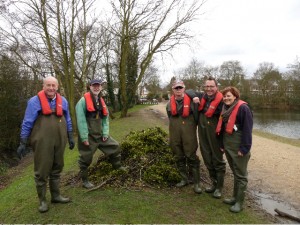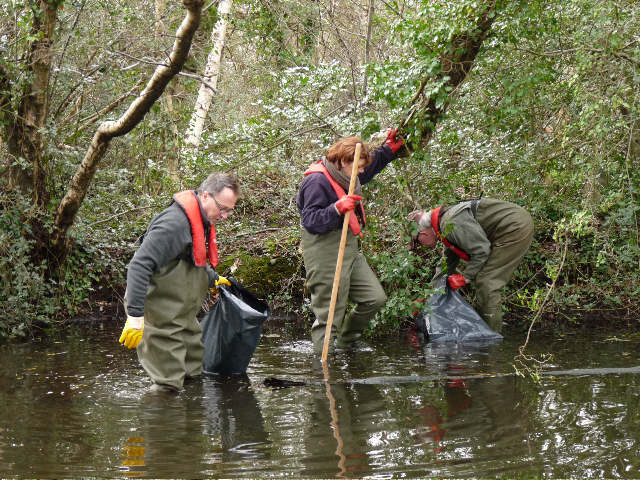On Sunday 2 March members of the Wren Group practical work team donned waders and life-jackets to clear areas of Floating Pennywort (Hydrocotyle ranunculoides) from the western end of Perch Pond. This aquatic plant, which grows on the surface of the water, is actually quite attractive, so why bother? Well, it is not a native species but adapts very well to conditions in the UK. It is capable of growing up to 15 metres from the side of a lake in a single growing season(that’s an astonishing 20cm per day) and up to 50cm thick. Smothering the surface of a water body, that inevitably means the ecology of the lake, pond or ditch is dramatically altered. Other plants will be crowded out, surface-feeding birds are denied a water surface to dabble in, and invertebrates in the water beneath are denied light.
 The plant is a native of North America but, being popular with the aquatic nursery industry, has colonised many other parts of the world, including South America and much of southern Europe. Although warnings about the risk of colonisation were aparently voiced as long ago as 1936, it first really began to spread in the UK after being sold for garden ponds in the 1980s.
The plant is a native of North America but, being popular with the aquatic nursery industry, has colonised many other parts of the world, including South America and much of southern Europe. Although warnings about the risk of colonisation were aparently voiced as long ago as 1936, it first really began to spread in the UK after being sold for garden ponds in the 1980s.
Floating Pennywort is not an easy plant to remove. Its fine roots grow from nodes and unless these are picked from the water they will simply re-grow. This is an example of good old-fashioned hand-removal being more effective, certainly in small areas of infestation, than mechanical methods, which can simply spread the plant to other areas.
Contractors brought in by the City of London Corporation had cleared some large areas of the plant in late January, but we were able to tackle some of the smaller clumps in the area near the tea hut. We will now be on the lookout to see where it re-establishes itself, since complete eradication is well nigh impossible. Having said that, work carried out to remove it from Heronry Lake a few years ago does appear to have been a complete success.
Tim Harris
Pics: Kathy Hartnett
